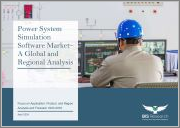
|
시장보고서
상품코드
1622833
아시아태평양의 전력 계통 시뮬레이션 소프트웨어 시장 : 용도별, 제품별, 국가별 - 분석과 예측(2023-2033년)Asia-Pacific Power System Simulation Software Market: Focus on Application, Product, and Country - Analysis and Forecast, 2023-2033 |
||||||
아시아태평양 전력 계통 시뮬레이션 소프트웨어 시장 규모는 2023년 4억 7,500만 달러에서 2033년 12억 8,350만 달러에 이르고, 예측기간인 2023-2033년 CAGR은 19.23%가 될 것으로 예측됩니다.
아시아의 전력 계통 시뮬레이션 소프트웨어 시장은 산업, 재생 가능 에너지, 전력 등의 업계에서 신뢰성 있고 효과적인 에너지 관리의 필요성이 높아지고 있기 때문에 급속히 확대되고 있습니다. 신재생에너지의 통합이 현저해짐에 따라, 고도의 시뮬레이션 툴의 필요성이 높아지고 있습니다. 모든 최적화는 이러한 도구에 달려 있습니다. 또한 환경 의식이 높아지고 기업이 이산화탄소 배출량을 줄이고 엄격한 규제를 준수하려고하는 동안 지속 가능한 에너지 관행이 추진되고 있습니다. 또한 수요에 박차를 가하고 있습니다. 시장 개척은 정부의 정책과 연구 개발에 대한 투자에 의해 더욱 가속되어 시장이 지속가능성의 목표와 기술 진보의 최전선에 머물도록 보장합니다.
| 주요 시장 통계 | |
|---|---|
| 예측 기간 | 2023-2033년 |
| 2023년 평가 | 4억 7,500만 달러 |
| 2033년 예측 | 12억 8,350만 달러 |
| CAGR | 19.23% |
아시아 전력 계통 시뮬레이션 소프트웨어 시장은 산업, 신재생에너지 발전, 발전 등 많은 산업에서 신뢰할 수 있는 계통 운용과 효율적인 에너지 관리 수요가 높아지면서 급속히 확대되고 있습니다. 이 지역이 재생 가능 에너지원의 통합으로 향함에 따라 전기를 최적화하고 그리드의 신뢰성을 높이기 위한 고급 시뮬레이션 툴의 필요성이 높아지고 있습니다. 이 프로그램은 최고 성능을 보장하고 운영 비용을 절감합니다.
시장 확대의 또 다른 중요한 요인은 아시아태평양의 스마트 그리드 기술의 급속한 개척입니다. 환경 의식의 향상과 지속가능성의 추진에 의해 업계 각사는 탄소 발자국을 최소한으로 억제해, 엄격한 규제에 준거하기 위한 시뮬레이션 툴의 도입을 진행하고 있습니다.
이 분야의 전력 계통 시뮬레이션 소프트웨어의 채용은 청정 에너지와 이산화탄소 삭감을 지원하는 정부의 대처나 인센티브에 의해서도 뒷받침되고 있습니다. 자사가 확대됨에 따라 향상되고 있으며, 보다 효과적이고 특정 지역의 에너지 요구에 적합한 것이 되고 있습니다. 수요가 예상됩니다.
이 보고서는 아시아태평양의 전력 계통 시뮬레이션 소프트웨어 시장을 조사했으며, 시장 개요와 함께 용도별, 제품별, 국가별 동향 및 시장 진출기업 프로파일 등의 정보를 제공합니다.
목차
주요 요약
제1장 시장
- 동향 : 현재 및 미래의 영향 평가
- 공급망 개요
- 연구개발 리뷰
- 규제 상황
- 주요 세계적 사건의 영향 분석-COVID-19, 러시아/우크라이나 분쟁, 중동 위기
- 시장 역학:개요
제2장 지역
- 지역별 개요
- 성장 촉진요인과 억제요인
- 아시아태평양
제3장 시장 - 경쟁 벤치마킹 및 기업 프로파일
- 향후 전망
- 지리적 평가
- Fuji Electric Co., Ltd.
제4장 조사 방법
JHS 25.01.09Introduction to Asia-Pacific Power System Simulation Software Market
The Asia-Pacific power system simulation software market is projected to reach $1,283.5 million by 2033 from $475.0 million in 2023, growing at a CAGR of 19.23% during the forecast period 2023-2033. The market for power system simulation software in Asia is expanding quickly due to the growing need for dependable and effective energy management in industries like industry, renewable energy, and power. Advanced simulation tools are becoming more and more necessary as smart grid technologies and renewable energy integration become more prominent. Enhancing grid reliability, increasing operational efficiency, and optimizing power distribution all depend on these tools. Demand is also being fueled by rising environmental consciousness and the drive for sustainable energy practices, as companies try to lower their carbon footprints and comply with strict regulations. Growth is being further accelerated by government policies and investments in research and development, guaranteeing that the market stays at the forefront of sustainability objectives and technological advancements.
Market Introduction
| KEY MARKET STATISTICS | |
|---|---|
| Forecast Period | 2023 - 2033 |
| 2023 Evaluation | $475.0 Million |
| 2033 Forecast | $1,283.5 Million |
| CAGR | 19.23% |
The market for power system simulation software in Asia is expanding rapidly due to the growing demand for dependable grid operations and effective energy management in a number of industries, such as industrial applications, renewable energy, and power generation. The need for sophisticated simulation tools to optimize power distribution and enhance grid reliability is growing as the region moves toward integrating renewable energy sources. By enabling stakeholders to examine and model different power scenarios, these software programs guarantee peak performance and lower operating expenses.
Another important factor driving the market's expansion is the quick development of smart grid technologies in Asia-Pacific. To handle the intricate relationships between power generation, distribution, and consumption, these grids need advanced simulation software. Additionally, growing environmental awareness and the drive for sustainability are encouraging industry players to adopt simulation tools that help minimize carbon footprints and comply with stringent regulations.
Power system simulation software adoption in the area is also being aided by government initiatives and incentives that support clean energy and carbon reduction. These tools' capabilities are being advanced by the growing public and private sector investments in research and development, which are making them more effective and suited to particular regional energy needs. Power system simulation software will continue to be in high demand as the APAC region builds its energy infrastructure.
Market Segmentation:
Segmentation 1: Application
- Power
- Industrial
- Others
Segmentation 2: by Module Type
- Power Flow
- Short Circuit
- Device Coordination
- Arc Flash
- Dynamic State Studies Module
- Renewable Energy Integration
- Energy Storage System Modeling
- Others
Segmentation 3: Country
- China
- Japan
- India
- South Korea
- Rest-of-Asia-Pacific
How can this report add value to an organization?
Product/Innovation Strategy: This report provides a comprehensive product/innovation strategy for the power system simulation software market, identifying opportunities for market entry, technology adoption, and sustainable growth. It offers actionable insights, helping organizations leverage power system simulation software to meet environmental standards, gain a competitive edge, and capitalize on the increasing demand for eco-friendly solutions in various industries.
Growth/Marketing Strategy: This report offers a comprehensive growth and marketing strategy designed specifically for the APAC power system simulation software market. It presents a targeted approach to identifying specialized market segments, establishing a competitive advantage, and implementing creative marketing initiatives aimed at optimizing market share and financial performance. By harnessing these strategic recommendations, organizations can elevate their market presence, seize emerging prospects, and efficiently propel revenue expansion.
Competitive Strategy: This report crafts a strong competitive strategy tailored to the APAC power system simulation software market. It evaluates market rivals, suggests methods to stand out, and offers guidance for maintaining a competitive edge. By adhering to these strategic directives, companies can position themselves effectively in the face of market competition, ensuring sustained prosperity and profitability.
Table of Contents
Executive Summary
Scope and Definition
1 Markets
- 1.1 Trends: Current and Future Impact Assessment
- 1.1.1 Trends: Current and Future Impact Assessment
- 1.1.1.1 Increasing Need for Grid Modernization
- 1.1.1.2 Accelerating Shift toward Renewable Energy Adoption
- 1.1.1 Trends: Current and Future Impact Assessment
- 1.2 Supply Chain Overview
- 1.2.1 Value Chain Analysis
- 1.2.2 End-User Value Chain
- 1.2.3 Pricing Forecast
- 1.3 Research and Development Review
- 1.3.1 Patent Filing Trend (by Country and Company)
- 1.3.2 Research Initiatives and Product Development Announcements (by Company)
- 1.3.2.1 Research Initiatives
- 1.3.2.2 Product Development Announcements
- 1.4 Regulatory Landscape
- 1.4.1.1.1 Implementing Operational Standards for Battery Energy Storage Systems
- 1.4.1.1.2 Hardware-in-the-loop Testing of Generator and Transformer Protection
- 1.4.2 End User and Buying Criteria
- 1.5 Impact Analysis for Key Global Events-COVID-19, Russia/Ukraine Conflict, or Middle East Crisis
- 1.6 Market Dynamics: Overview
- 1.6.1 Market Drivers
- 1.6.1.1 Rising Demand for Electricity to Propel the Expansion of the Power System Simulation Software Market
- 1.6.1.2 Favorable Policies and Regulatory Frameworks to Drive Growth in the Market
- 1.6.1.3 Enhanced Capabilities of Simulation Software to Reduce Project Time and Cost
- 1.6.2 Market Restraints
- 1.6.2.1 High Investment and Deployment Costs
- 1.6.2.2 Concerns Surrounding Data Security
- 1.6.3 Market Opportunities
- 1.6.3.1 Rise of Smart Energy Infrastructure Worldwide
- 1.6.3.2 Renewable Energy Integration Using Simulation Software
- 1.6.1 Market Drivers
2 Regions
- 2.1 Regional Summary
- 2.2 Drivers and Restraints
- 2.3 Asia-Pacific
- 2.3.1 Regional Overview
- 2.3.2 Driving Factors for Market Growth
- 2.3.3 Factors Challenging the Market
- 2.3.3.1 Application
- 2.3.3.2 Product
- 2.3.4 China
- 2.3.4.1 Application
- 2.3.4.2 Product
- 2.3.5 Japan
- 2.3.5.1 Application
- 2.3.5.2 Product
- 2.3.6 India
- 2.3.6.1 Application
- 2.3.6.2 Product
- 2.3.7 South Korea
- 2.3.7.1 Application
- 2.3.7.2 Product
- 2.3.8 Rest-of-Asia-Pacific
- 2.3.8.1 Application
- 2.3.8.2 Product
3 Markets - Competitive Benchmarking & Company Profiles
- 3.1 Next Frontiers
- 3.2 Geographic Assessment
- 3.2.1 Fuji Electric Co., Ltd.
- 3.2.1.1 Overview
- 3.2.1.2 Top Products/Product Portfolio
- 3.2.1.3 Top Competitors
- 3.2.1.4 Target Customers
- 3.2.1.5 Key Personnel
- 3.2.1.6 Analyst View
- 3.2.1.7 Market Share, 2022
- 3.2.1 Fuji Electric Co., Ltd.
4 Research Methodology
- 4.1 Data Sources
- 4.1.1 Primary Data Sources
- 4.1.2 Secondary Data Sources
- 4.1.3 Data Triangulation
- 4.2 Market Estimation and Forecast



















